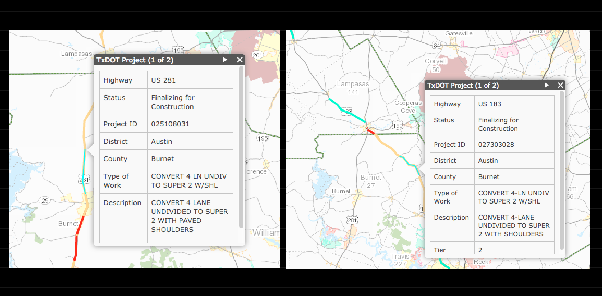Commissioners hear about TxDOT US 281/183 Super 2 conversion

TxDOT Project Tracker details plans for US 281 and US 183 Super 2 development.
By Lew K. Cohn
Managing Editor
The Highlander
A construction project to convert the northern part of US 281 from the Lampasas County line to the Burnet city limits to a four-lane undivided highway into a “Super 2” three-lane highway has been let this month, Texas Department of Transportation (TxDOT) area engineer Cathy Kratz P.E. said at Tuesday's Burnet County Commissioner Court meeting.
Kratz and other engineers from TxDOT appeared before commissioners to talk about plans to put convert portions of US 281 and US 183 to “Super 2” roadways, due to a high number of accidents which have occurred where vehicles have left the roadway.
“In some areas on US 281, there are no shoulders, so we have seen a high percentage of accidents in which vehicles have left the roadway,” Kratz said. “Sixty percent of the accidents reported in that area have been run off the road accidents and that is the driving factor. If we put in a three-lane Super 2 highway, we get the shoulders back.”
According to TxDOT, a Super 2 highway has a periodic passing lane added to a two-lane highway to allow passing of slower vehicles and the dispersal of traffic platoons. The passing lane alternates from one direction of travel to the other within a section of roadway, allowing passing opportunities in both directions.
Super 2 projects can be introduced to existing roadways where there is a significant amount of slow moving traffic, limited sight distance for passing, or existing traffic volume has exceeded the highway capacity, creating the need for vehicles to pass on a more frequent basis.
Kratz said the roadway will be restriped and resurfaced to create two 11-foot lanes with an alternating 11-foot passing lane. Shoulders will be improved to eight feet on the side of the road with a single lane and three feet on the side of the road where the dual lanes run.
The passing lane will be set up in alternating two-mile segments, but where TxDOT has identified driveways which come out onto US 281, there will be a left turn only lane instead with four-foot shoulders on either side. Driveways will be rebuilt into a flared design which will make them easier to access from the roadway, which is part of an effort to get turning traffic off the road quicker to improve roadway safety, Kratz said.
The cost of the US 281 project, which will be done in two sections, is $3,661,548. A similar project to convert US 183 from the Lampasas County line to the Williamson County line will cost $1,359,610.
Burnet County Judge James Oakley said US 281 has seen an increase in traffic because “a lot of people are using it as an alternative to I-35, since it goes from the Rio Grande Valley to the Canadian border. With all of the congestion on I-35, US 281 is getting used quite a lot.”
One area resident, Will Mulholland, expressed concern that sometimes traffic will need to turn right into a driveway from a single lane.
“Cars will have to slow down and stop when the car in front of them is turning and I think that could create a larger problem when you drop from four lanes to three,” Mulholland said.
Oakley invited anyone who wishes to review the plans for the Super 2 project to visit with Kratz at the area engineer office in Burnet at 3029 E. SH 29 or by calling (512) 756-2316.
In other action Tuesday, commissioners voted to deobligate the county from a $223,000 County Essential Services grant from the Office of the Governor that would have been used to pay for the capital murder trial of a defendant from Blanco County.
District Attorney Wiley “Sonny” McAfee explained the grant was no longer necessary after the defendant, John Cody Lawrence, 24, appeared before District Judge Allan Garrett and pleaded guilty to capital murder of a child under the age of 10, as well a four counts of assaulting a public servant.
“Once we obtained the grant and the defendant read in the newspaper that we had the funds to pay for a capital murder trial, he decided to resolve the case by giving up all of his appeals and agreeing to accept a plea in exchange for a life sentence without parole,” McAfee said. “It took us just seven months to resolve this case and we appreciate the commissioners for helping us get this grant, which made it possible to move quickly on this case.”
By voting to notify the Office of the Governor the county no longer needs the grant, it will allow the money to be unencumbered so it could be applied to other grant programs through the state, McAfee said.
Commissioners also voted to apply for a number of grants, including two for McAfee's department. One is for a $42,000 grant to help fund a child abuse prosecutor for the 33rd and 424th Judicial Districts through a Justice Assistance Grant with the Criminal Justice Division of the Office of the Governor. McAfee said the department has had the grant for three years already and it has paid at a sliding scale. In the first year, the grant funded the position fully, while in year two it paid at 80 percent and in year three it paid at 40 percent. The $42,000 would be 40 percent of the funding needed for the position.
“We have benefitted from having a child abuse prosecture that is dedicated to trying cases involving sexual and physical abuse,” McAfee said. “We have a very high rate of prosecution on these cases and they are the ones which most frequently go to trial. Often, the sentences returned in these cases are multiple life sentences.”
Another grant being sought by McAfee is to apply for a new drug case prosecutor, again seeking funding from the Justice Assistance Grant Program. In the past, the DA's office did have a drug case prosecutor which was funded through grant monies, but that has not been the case since 2005-2006.
“When I came into the office four years ago, we were having 850 felony drug cases a year and last year we had more than 1,400 cases,” McAfee said. “The amount of drug cases we've seen is the largest increase in our caseload. We want to have someone in here who can help us get the backload of cases out of our county jails and into TDC or diverted into treatment programs if that is what is warranted.”
McAfee said the cost of the position is $95,721.55, but he is not sure whether the grant, if awarded, would be a descending grant that would require the county to pick up more of the cost over time, though it is a possibility that drug forfeiture money could help offset some of those costs.
Other grants commissioners agreed to apply for include:
* A grant to fund the District Drug Court program.
* A two-year continuation grant to fund the Victim Assistance Coordinator position in the county.
* A grant to fund a dual diagnosis mental health specialty court position.
* A grant for a new position at the Sheriff's office of a sex offender registrar, who would be responsible for keeping up with the 99 registered sex offenders in the unincorporated areas of the county and making sure any new ones are registered. When not carrying out those duties, the deputy would assist in the working of sex crimes and crimes against women.






